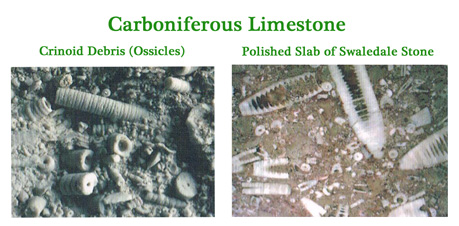Swaledale Fossil Limestone for King Richard’s Tomb
Leicester Cathedral Publishes Plans for the Tomb of King Richard III – Fossils to Play a Role
Church authorities at Leicester Cathedral have announced plans for the burial tomb of King Richard III. The impressive tomb, is the proposed final resting place of Richard of York who was killed at the Battle of Bosworth Field in in 1485, although there is a strong campaign to have Richard’s remains returned to York for burial. Leicester Cathedral’s plans are for a stone tomb, carved with a deep cross and set upon an engraving of a white Yorkshire rose. The project is likely to cost something like £1.3 million to complete.
King Richard III
The stone that is intended to be used is Swaledale limestone, highly appropriate as this stone is from Swaledale (naturally), part of the magnificent North Yorkshire countryside. Although this stone comes in various colours, greys, off-white and even with a blueish hue it is highly fossiliferous. The limestone was formed at the bottom of a shallow sea that covered much of what was to become the United Kingdom back in the early Carboniferous geological period.
Swaledale Fossil Limestone
It is coarse grained and contains a substantial amount of fossil remains of invertebrate marine creatures, most notably the flexible stems of sea lilies otherwise known as crinoids. Crinoids belong to the same phylum as starfishes and sea urchins, they look superficially like plants (hence the name sea lily), but they are in fact an animal. Entirely marine, crinoids have been around since the Cambrian and can still be found today. Typically, crinoids consisted of a hold fast to anchor them to the sea-bed and a flexible stem made up of calcite plates (called stem ossicles or columnals), which supported umbrella-like branching tubular arms that were able to trap food items in passing currents. When the creature dies, the minute organic fibres that held the stem ossicles together rot and the stem disintegrates.
In the ancient limestone beds of Swaledale crinoids were so numerous that their fossils form a substantial part of the rocks.
When polished, the fossils show up very clearly and the details of the stem ossicles can be seen very clearly.
Fossil Rich Carboniferous Limestone
Picture credit: Open University
We are not sure whether there is any record of Richard of York being an avid collector of fossils, but if the tomb is built, visitors to the Cathedral will be able to view evidence of life in a prehistoric sea as well as learning about the last Plantagenet King of England.
The fossilised stems of crinoids are also known as “St Cuthbert’s beads”. St Cuthbert was a monk at the monastery located at Lindisfarne, otherwise called Holy Island (Northumberland), local legend states the Cuthbert would make rosaries by threading a thin piece of thread through columnals that he had collected on the shore.
For models and replicas of ancient creatures including Palaeozoic and Mesozoic animals: CollectA Prehistoric Life Figures and Models.


